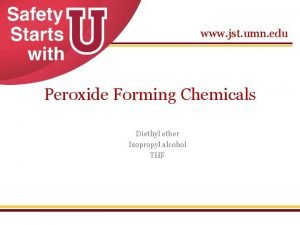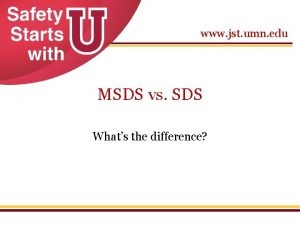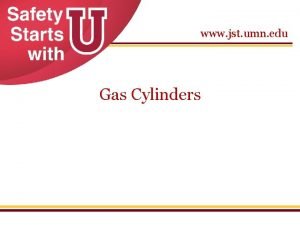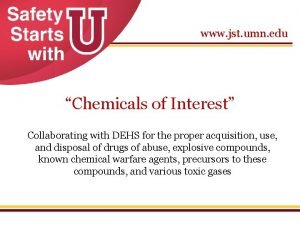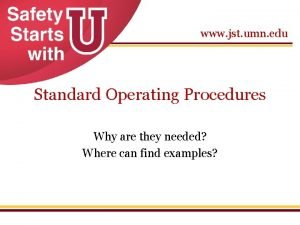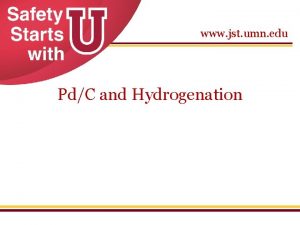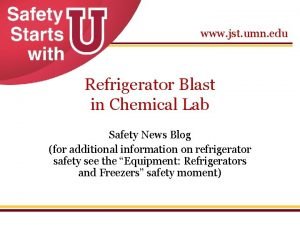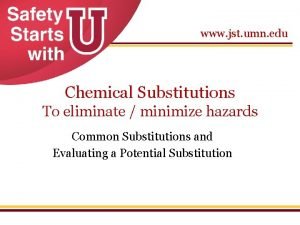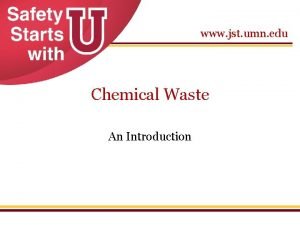www jst umn edu Pregnancy and Chemical Research






- Slides: 6

www. jst. umn. edu Pregnancy and Chemical Research Identifying exposure, assessing risk, and mitigating risk

Pregnancy and Chemical Researchers in chemical labs who are pregnant need to be aware of potential health hazards to them and their fetus • Teratogens • Ionizing radiation • Infectious diseases When a worker becomes aware of a pregnancy, they should: • Identify potential exposure to hazards • Consult resources regarding those hazards • Develop risk mitigation strategies European Agency for Safety and Health at Work. Directive 2007/30/EC of the European Parliament and of the Council of 20 June 2007 Kling, Jim “Alone in Lab. ” Science Career Magazine 7 April 2006 <http: //sciencecareers. sciencemag. org/career_magazine/previous_issues/articles/2006_04_07/nodoi. 16787403986169116343> 2

Identifying Exposure • Chemical – Teratogens • Biological – Infectious diseases • Physical – – – Examples of Known Teratogens Arsenic, Cadmium, Lead, Mercury Benzene, Toluene, Xylene Ethylene Oxide, Ethylene Glycol, Vinyl Chloride Keep in mind that exposure limits are often several orders of magnitude lower for pregnant women due to fetus sensitivity. Exposure is especially significant in the first 14 to 60 days of pregnancy. Noise Radiation Extreme cold/heat Heavy lifting Physical fatigue (standing or sitting too long) University of Minnesota Chemical Hygiene Plan accessed 4 April 2013 http: //www. chem. umn. edu/services/safety/tables/tab. XVIII. htm European Agency for Safety and Health at Work. Directive 2007/30/EC of the European Parliament and of the Council of 20 June 2007

Assessing Risk • Consult at least 2 -3 health sources regarding hazard – Material safety data sheets (MSDS) – National Institute for Occupational Safety and Health (NIOSH) – Occupational Safety and Health Administration (OSHA) • Understand amount and duration of exposure – Consider volumes, concentrations – Exposure testing is available through DEHS Kling, Jim “Alone in Lab. ” Science Career Magazine 7 April 2006 <http: //sciencecareers. sciencemag. org/career_magazine/previous_issues/articles/2006_04_07/no doi. 16787403986169116343> MSDS for benzene

Mitigating Risk • Work with someone to develop a plan to avoid exposure to hazards – Principle Investigator – Lab Safety Officer – DEHS Contact • You can choose to treat all chemicals as potentially hazardous substances – Use engineering controls (hoods, shields) – Always wear proper PPE; perhaps increase frequency of glove changes, consider splash apron, etc. – When in doubt, ask Dicks, Lynn “The Top 5 Challenges for Pregnant Scientists. ” Science Career Magazine 7 April 2006 <http: //sciencecareers. sciencemag. org/career_magazine/previous_issues/articles/2006_04_07/no doi. 10636024449169885694> Pregnant workers who declare their pregnancy have a right to request accommodation to avoid exposure to reproductive hazards

Additional Resources • Science Careers magazine feature articles on Pregnancy & the Lab – http: //sciencecareers. sciencemag. org/career_magazine/previous_issues/articles/2006_0 4_07/nodoi. 14914624199943288521 • 1992 European Directive on pregnant women and new mothers (law in European Union, helpful ideas for discussing risk mitigation with superiors) – https: //osha. europa. eu/data/legislation/10 • Departmental Chemical Hygiene Plan – http: //www. chem. umn. edu/services/safety/Chem. Hyg. Plan. html • International Labor Organization Reproductive Health Hazards Module (includes more comprehensive teratogen list) – http: //actrav. itcilo. org/actrav-english/telearn/osh/rep/prod. htm
